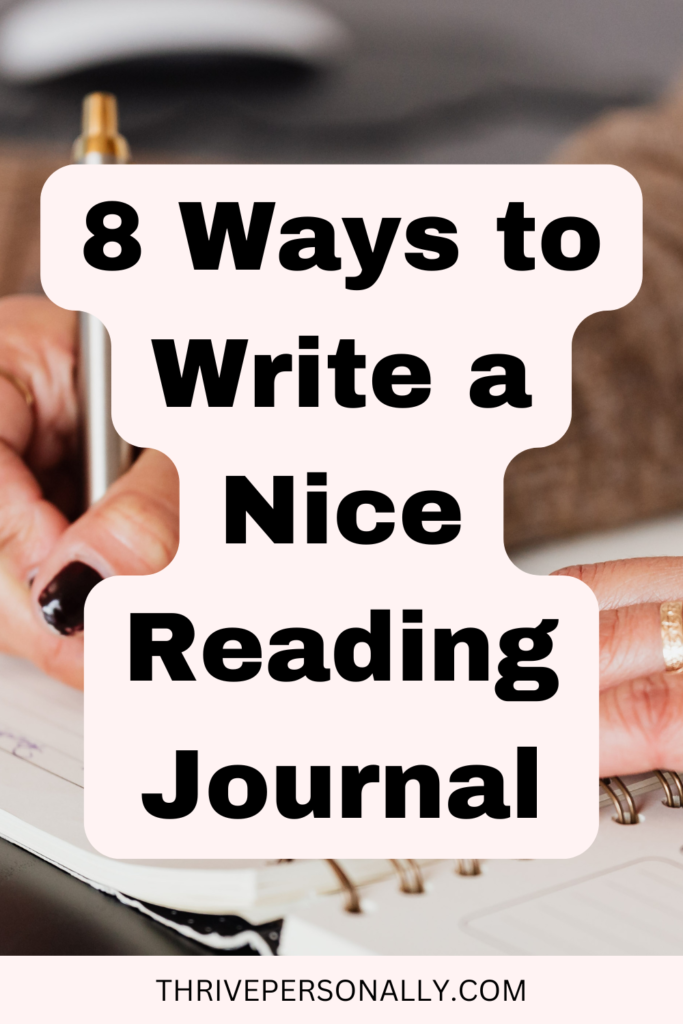A reading journal is a personal tool that assists you in tracking and reflecting on the books you read. It serves as a space where you can not only jot down summaries or interesting quotes but also express your thoughts, feelings, and connections regarding the stories you encounter. By keeping a reading journal, you create a meaningful dialogue with each book, enhancing your overall experience as a reader.
The importance of a reading journal cannot be overstated. When you write about the books you read, you engage with the material on a deeper level. This active involvement helps improve your comprehension and retention of the story. Rather than passively absorbing the content, you start to analyze characters, themes, and plots, asking yourself questions and forming opinions. This process can significantly boost your understanding, making the stories more enjoyable and memorable.
How to Write a Nice Reading Journal
1. Choosing Your Journal
When it comes to starting a reading journal, one of the first decisions you will need to make is selecting the right type of journal that fits your preferences and needs. There are several options to consider, including traditional notebooks, digital journals, and various apps designed for journaling. Each choice has its advantages and disadvantages, so it is important to evaluate these factors carefully.
Traditional notebooks are a popular choice for many middle schoolers. Writing by hand can promote better memory retention, helping you reflect on the stories you read. You can choose a design that speaks to you, whether it’s a simple lined notebook or a fancy one with artistic themes. However, one downside is that you cannot easily edit your entries, which may limit your creativity when revisiting your thoughts.
On the other hand, digital journals offer a modern and convenient alternative. With options like Google Docs or specific journaling apps such as Day One, you can easily type your thoughts, organize your entries, and search through them quickly. Digital journals also allow for the integration of multimedia, like images or links to interesting articles, making them more engaging. However, some people may find it less personal than writing by hand.
Read Also: 15 Books Every Woman Needs to Read in Her Lifetime
2. Setting Up Your Journal
Creating a reading journal is an enjoyable way to enhance your understanding of books and develop your writing skills. To start, you must consider the structure and components that will make your journal easy to navigate and organized. First, set up a title page. This page should include your name, the date you start the journal, and a catchy title that reflects your personality or love for reading. This title page sets the tone and can inspire you to keep writing.
Next, it is essential to include an index. An index helps you quickly locate entries related to specific books or themes. You can create it by listing the titles or topics covered in your journal, along with their corresponding page numbers. This feature will save you time and energy when you want to revisit your thoughts on a particular book.
Another key aspect of your reading journal is to have different sections for varying types of entries. For example, you might want a section dedicated to summaries, where you write brief overviews of each book you read. Another section can focus on insights or themes; here, you reflect on lessons learned or analyze key ideas. Furthermore, you may include a space for quotes that resonate with you, allowing you to capture the essence of what you read.
Read Also: 15 Life-Changing Benefits of Journaling
3. Types of Entries to Include
When you start your reading journal, there are several types of entries you can include to enhance your experience. These entries not only help you remember the stories but also allow you to connect with the material on a deeper level. Here are some key types of entries that you might find useful.
First, you can write summary notes. A summary allows you to condense the main points of the book or chapters you’ve read. Try to capture the essence of the story in your own words. This exercise not only reinforces your understanding but also makes it easier to recall important details later on. Summaries should be brief but sufficient to give you a clear picture of the storyline.
Another valuable entry is a personal reflection. This is your chance to express your thoughts and feelings about the book. Ask yourself questions like: How did the story make you feel? Were there any moments that surprised you? Sharing your personal insights helps you connect with the text on a more emotional level, making the reading experience more meaningful.
Character analysis is also an important aspect of a reading journal. You can choose a character you relate to or find interesting and analyze their traits, motivations, and development throughout the story. Understanding characters better can provide you with insights into the themes of the book and the author’s message.
Lastly, consider noting down quotes that resonate with you. A powerful sentence or a thought-provoking dialogue can sometimes capture the essence of the book better than a summary. When you find a quote that stands out, write it down along with your reflections on why it struck a chord with you.
Read Also: 50 Mindfulness Quotes for Finding Peace
4. Writing Honest Reflections
When you start writing a reading journal, it is essential to focus on writing honest reflections about the books you read. Being honest means sharing your true thoughts and feelings, rather than just what you think others want to hear. Each time you delve into a new book, take a moment to pause and think about how it makes you feel. Do you find the story engaging? Are the characters relatable? Your reflections should capture your personal reactions, as these unique insights are what make your journal special.
It’s important to remember that everyone experiences stories differently. What resonates with you may not resonate with someone else. Therefore, do not hesitate to express your opinions, even if they are different from those around you. You have the right to feel how you feel about a book, and exploring those feelings can deepen your understanding of both the text and yourself as a reader. This process encourages you to think critically, ask questions, and develop your perspective.
Writing about your feelings and thoughts helps you grow, not only as a reader but also as a thinker. When you engage with a book on a personal level, you place yourself in the characters’ shoes or consider the themes presented. This practice can lead to meaningful connections and greater comprehension. As you write, think about what you liked, what you did not like, and why. This will help you uncover layers of meaning that can transform your reading experience.
5. Adding Creativity to Your Journal
When you write in your reading journal, you have a wonderful opportunity to express yourself creatively. By adding unique visual elements, you can make your journal not only a record of what you read but also a reflection of your personal style. One simple way to do this is through doodling. You can draw small pictures related to the stories or characters in your books, which can help you remember them better. For instance, if you read about a brave knight, you might sketch a small sword or a dragon in the margins of your entries.
Collaging is another exciting option for your reading journal. You can cut out pictures or words from magazines that resonate with the themes of your books. This practice not only makes your journal visually interesting but also lets you create a mood or tone that captures the essence of the stories you are exploring. Picture using images of forests, oceans, or even cities for books set in those locations, allowing you to create a mini-storyboard on the pages.
Using colored pens or markers can significantly enhance the look of your entries. By incorporating different colors, you can categorize your thoughts or emphasize certain points. For example, you could use one color for main ideas, another for characters, and yet another for your personal reflections. This color-coding technique will make your entries easier to skim and reference later.
6. Setting Reading Goals
Setting reading goals is a crucial step in creating an effective reading journal. You want to challenge yourself while also making your reading experience enjoyable. One way to start is by deciding how many books you aim to read each month. For example, you might set a goal to read two books every month. This gives you a clear target to work towards and allows you to keep track of your progress in your journal.
Additionally, it can be beneficial to explore new genres. If you primarily read fiction, consider setting a goal to read at least one non-fiction book each month. This not only broadens your reading experience but also helps you discover different writing styles and perspectives. You could even make a list of genres you want to explore, such as mystery, science fiction, biography, or poetry, and include a plan for how many books from each genre you would like to read over a certain period.
Another effective way to set goals is to create specific and measurable targets. Instead of saying, “I want to read more,” try saying, “I will read 30 pages each day.” This kind of goal is straightforward and helps you establish a reading routine. You can track your daily reading in your journal, which provides not just motivation but also a sense of accomplishment. Don’t hesitate to adjust your goals as needed based on your progress or interests; flexibility is key to maintaining your love for reading.
7. Reviewing Your Journal
Periodically reviewing your reading journal can be a rewarding experience that offers numerous benefits. By taking the time to reflect on your past entries, you can see how much you have grown as a reader. This growth is not just about the number of books you have read but also about how your understanding and appreciation of literature have evolved over time.
You might notice that your thoughts on certain books have changed, or you may have developed a preference for specific genres or authors. This discovery can be quite fulfilling and can motivate you to explore new reading materials.
Another advantage of reviewing your journal is the ability to identify recurring themes in your reading choices. You may find that you are drawn to stories about friendship, adventure, or personal growth. Recognizing these trends can help you make better reading choices in the future because you will have a clearer idea of what interests you. Furthermore, these insights can enhance your enjoyment of reading as you seek out titles that resonate with your preferred themes.
8. Sharing Your Journal Experience
Once you have created your reading journal and filled it with your thoughts and reflections, it can be very rewarding to share your experiences with others. Sharing your journal is not only a way to connect with friends and family, but it can also enhance your understanding of the books you’ve read. When you discuss your journal, you open the door to new perspectives that can deepen your appreciation for literature.
Consider sharing your reading journal with friends in your class or joining a reading group. This will allow you to exchange ideas and thoughts about various books. By talking about the themes and characters you’ve noted in your journal, you may discover insights that you had not considered before. For example, a friend might interpret a character’s actions differently, prompting an exciting discussion that could help you see the story in a new light.
Another benefit of sharing your reading journal is the ability to inspire others. When they see your enthusiasm for reading and the effort you put into your journal, they may want to start their own. This can create a ripple effect, sparking interest in literature in those around you. Moreover, discussing your journal entries might motivate your peers to explore new genres or authors, broadening their horizons.
Save the pin for later



